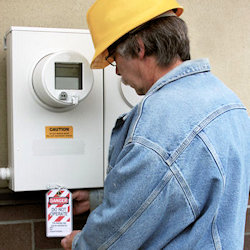Sources of Hazardous Energy During Maintenance and Repair
In addition to the hazardous motions and actions machinery might have that require safeguards, many other hazardous conditions may exist to which workers may be exposed while performing maintenance or operation.
Electrical hazards are especially important because it could result in unexpected machine startup during maintenance. We'll cover the use of Lockout/Tagout to control this hazard category.

The following 13 hazard categories are adapted from Product Safety Management and Engineering, by Willie Hammer. Workers need to be aware of these hazards whenever performing maintenance or operating machinery.
- Acceleration (Motion Hazards): Sudden movement of machine parts can occur when guards are removed. Example: A worker removes a guard to service a conveyor belt; the belt is inadvertently activated, pulling in tools or limbs.
- Biohazards: Maintenance may expose workers to harmful bacteria or mold, especially when machines process organic material. Example: Cleaning a food processing machine without proper PPE exposes a worker to harmful bacteria.
- Chemical Reactions: Contact with or mixing of incompatible chemicals during maintenance can cause violent reactions. Example: A worker uses a cleaner on a machine part containing chemical residue, resulting in a dangerous reaction.
- Electrical Hazards: Energized parts may still carry current if not fully de-energized or locked out. Example: A worker receives an electric shock from residual energy while replacing a component inside an opened control panel.
- Ergonomics: Maintenance tasks often require awkward postures or forceful movements. Example: A technician strains their back while reaching into a machine to remove a part due to poor access design.
- Explosives and Explosions: Flammable gases or dust may ignite during maintenance activities. Example: Using a power tool that sparks in a dusty area leads to an explosion.
- Flammability and Fires: Flammable substances and ignition sources are often present near machines. Example: Welding near oil residue on machinery starts a fire.
- Temperature Extremes: Machines may have hot or cold surfaces even after being shut down. Example: A worker suffers burns while touching a still-hot engine component during servicing.
- Radiation: Some machines emit non-ionizing radiation, such as UV, which can harm skin or eyes. Example: Servicing a UV-curing lamp without protection causes skin burns.
- Toxins: Hazardous chemicals may be present during cleaning or servicing. Example: Removing buildup inside a machine exposes the worker to toxic fumes from chemical residues.
- Vibration/Noise: Maintenance with power tools can expose workers to harmful noise and vibration. Example: Extended use of a pneumatic wrench without hearing protection causes hearing damage.
- Stored Energy: Components like springs, flywheels, or hydraulics can retain energy after shutdown. Example: A spring-loaded mechanism snaps back when a guard is removed, injuring a hand.
- Unexpected Startup: Equipment can start unexpectedly if not properly locked out. Example: A machine restarts while a worker is inside it because someone mistakenly believes it’s safe to operate.
Knowledge Check Choose the best answer for the question.
6-2. What must be done before maintenance work begins to prevent electrical hazards?
You forgot to answer the question!
